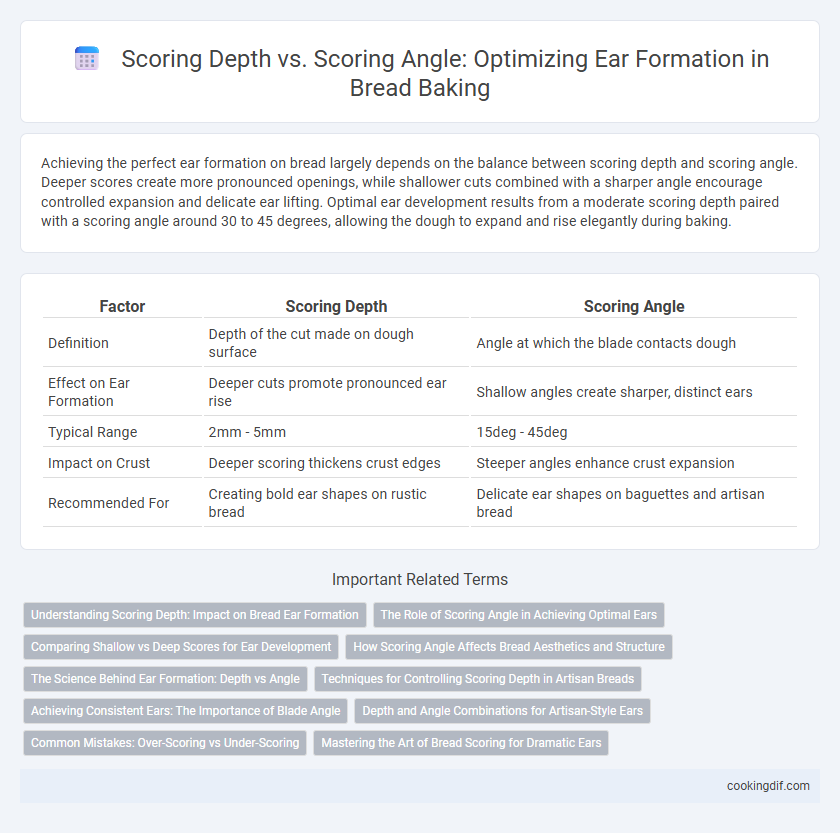Achieving the perfect ear formation on bread largely depends on the balance between scoring depth and scoring angle. Deeper scores create more pronounced openings, while shallower cuts combined with a sharper angle encourage controlled expansion and delicate ear lifting. Optimal ear development results from a moderate scoring depth paired with a scoring angle around 30 to 45 degrees, allowing the dough to expand and rise elegantly during baking.
Table of Comparison
| Factor | Scoring Depth | Scoring Angle |
|---|---|---|
| Definition | Depth of the cut made on dough surface | Angle at which the blade contacts dough |
| Effect on Ear Formation | Deeper cuts promote pronounced ear rise | Shallow angles create sharper, distinct ears |
| Typical Range | 2mm - 5mm | 15deg - 45deg |
| Impact on Crust | Deeper scoring thickens crust edges | Steeper angles enhance crust expansion |
| Recommended For | Creating bold ear shapes on rustic bread | Delicate ear shapes on baguettes and artisan bread |
Understanding Scoring Depth: Impact on Bread Ear Formation
Scoring depth plays a critical role in ear formation during bread baking by controlling steam release and crust expansion. Deeper scores allow the dough to open more sharply, creating pronounced ears, while shallower scores result in minimal ear development and a smoother crust. Optimal scoring depth varies by dough hydration and fermentation but generally ranges between 3 to 5 millimeters to balance strength and aesthetic ear formation.
The Role of Scoring Angle in Achieving Optimal Ears
The scoring angle plays a crucial role in achieving optimal ear formation during bread baking by influencing the depth and expansion of the cut. A steeper scoring angle allows for better control of the dough's expansion, promoting well-defined and pronounced ears. Precise adjustment of the scoring angle, combined with the right scoring depth, enhances the aesthetic and structural quality of the crust, resulting in a visually appealing and artisanal loaf.
Comparing Shallow vs Deep Scores for Ear Development
Shallow scoring angles create minimal crust breakage, resulting in a subtle ear with restrained oven spring, while deep scoring promotes extensive dough expansion and a pronounced ear with sharp, defined edges. The depth of the score directly impacts the extent of gas release and crust formation, influencing the bread's aesthetic and texture. Optimal ear development balances score depth and angle to control oven spring and create a visually appealing, crisp crust.
How Scoring Angle Affects Bread Aesthetics and Structure
Scoring angle significantly influences the aesthetics and structure of bread by controlling the expansion and shape of the ear during baking. A shallow scoring angle creates a wider ear with a softer crust, enhancing the visual appeal and texture, while a steeper angle results in a narrower, more pronounced ear that contributes to a crispier crust. Adjusting the scoring angle allows bakers to optimize the bread's appearance and crumb structure, ensuring an ideal balance between crust crispness and ear definition.
The Science Behind Ear Formation: Depth vs Angle
The science behind ear formation in bread involves optimizing scoring depth and angle to control dough expansion during baking. Deeper scoring allows for more dramatic ear development by directing steam release and crust formation, while the angle influences the shape and height of the ear by affecting the dough's surface tension. Precise control of both scoring depth and angle is essential for achieving the desired crust texture and visual appeal in artisanal bread.
Techniques for Controlling Scoring Depth in Artisan Breads
Scoring depth directly influences ear formation by controlling the bread's expansion during baking, with optimal depths ranging between 3 to 5 millimeters for artisan loaves. Scoring angle, typically between 30 to 45 degrees, affects the ear's height and definition, creating crisp edges and aesthetic appeal. Techniques such as adjusting blade sharpness, hand pressure, and angle precision ensure consistent depth control, crucial for achieving signature ears in sourdough and baguette varieties.
Achieving Consistent Ears: The Importance of Blade Angle
Achieving consistent ears in bread scoring requires precise control over both scoring depth and blade angle, as the blade angle directly influences the ear's lift and shape during oven spring. A shallow blade angle, typically around 20 to 30 degrees, facilitates the formation of a pronounced ear by allowing the dough layers to separate and rise effectively. Scoring too deeply or at a steep angle can inhibit ear formation, emphasizing the importance of a consistent, controlled blade angle for optimal crust development and aesthetic appeal.
Depth and Angle Combinations for Artisan-Style Ears
Optimal scoring depth and angle significantly influence artisan-style ear formation in bread, with deeper scores around 3-5 mm and a scoring angle between 30deg and 45deg yielding pronounced, well-defined ears. Shallow depth scoring under 2 mm often results in insufficient ear rise, while angles steeper than 60deg tend to reduce ear length and create irregular splits. Achieving the perfect balance in depth and angle promotes controlled oven spring and enhances crust texture and visual appeal.
Common Mistakes: Over-Scoring vs Under-Scoring
Scoring depth directly influences ear formation by controlling dough expansion during baking, with shallow scores causing under-expansion and minimal ear development. Excessive scoring depth can lead to over-expansion, damaging loaf structure and causing ear collapse. Maintaining an optimal scoring angle between 30 to 45 degrees ensures precise dough release, preventing common mistakes of over-scoring that create excessive cuts or under-scoring that restrict ear growth.
Mastering the Art of Bread Scoring for Dramatic Ears
Scoring depth significantly influences ear formation in bread, as deeper cuts encourage pronounced and dramatic ears by directing controlled expansion during baking. Optimal scoring angles, typically between 30 to 45 degrees, facilitate ear lift by creating tension along the dough's surface, enhancing oven spring and visual appeal. Mastery of both scoring depth and angle is essential for bakers aiming to achieve distinctive, well-defined ears that showcase artisanal craftsmanship.
Scoring depth vs scoring angle for ear formation Infographic

 cookingdif.com
cookingdif.com